source: CDC
Based on publicly available data from the CDC/HHS, it is unclear how many of the 72.4 million doses:
 https://abs.twimg.com/emoji/v2/... draggable="false" alt="🔸" title="Kleine orangene Raute" aria-label="Emoji: Kleine orangene Raute">have actually been administered vs. how many are in storage
https://abs.twimg.com/emoji/v2/... draggable="false" alt="🔸" title="Kleine orangene Raute" aria-label="Emoji: Kleine orangene Raute">have actually been administered vs. how many are in storage
 https://abs.twimg.com/emoji/v2/... draggable="false" alt="🔸" title="Kleine orangene Raute" aria-label="Emoji: Kleine orangene Raute">carried-over from the long-term care vaccination program (ended April 23, 2021)
https://abs.twimg.com/emoji/v2/... draggable="false" alt="🔸" title="Kleine orangene Raute" aria-label="Emoji: Kleine orangene Raute">carried-over from the long-term care vaccination program (ended April 23, 2021)
source: CDC/HHS
source: CDC/HHS
This is based on historical data obtained by @KHNews
(ie. 0.753% x 72.4 million) https://khn.org/news/article/cvs-and-walgreens-have-wasted-more-vaccine-doses-than-most-states-combined/">https://khn.org/news/arti...
We do not, know how many of these were actually *administered* in retail pharmacies, however.
source: CDC
source: CDC
In Kentucky, nearly 1 in 3 COVID-19 vaccine doses are allocated to retail pharmacies.
source: CDC
source: CDC
source: CDC
source: CDC, KFF
KFF analysis URL: https://www.kff.org/policy-watch/supply-vs-demand-which-states-are-reaching-their-covid-19-vaccine-tipping-points/">https://www.kff.org/policy-wa...
So, why is the federal retail pharmacy program good in some instances, but not in others? At least part of the difference has to do with the ratio of population-to-pharmacies  https://abs.twimg.com/emoji/v2/... draggable="false" alt="👀" title="Augen" aria-label="Emoji: Augen">
https://abs.twimg.com/emoji/v2/... draggable="false" alt="👀" title="Augen" aria-label="Emoji: Augen"> https://abs.twimg.com/emoji/v2/... draggable="false" alt="⤵️" title="Nach rechts zeigender Pfeil mit Krümmung nach unten" aria-label="Emoji: Nach rechts zeigender Pfeil mit Krümmung nach unten">
https://abs.twimg.com/emoji/v2/... draggable="false" alt="⤵️" title="Nach rechts zeigender Pfeil mit Krümmung nach unten" aria-label="Emoji: Nach rechts zeigender Pfeil mit Krümmung nach unten">
 https://abs.twimg.com/emoji/v2/... draggable="false" alt="🔸" title="Kleine orangene Raute" aria-label="Emoji: Kleine orangene Raute">Nevada: 11300 persons/pharmacy
https://abs.twimg.com/emoji/v2/... draggable="false" alt="🔸" title="Kleine orangene Raute" aria-label="Emoji: Kleine orangene Raute">Nevada: 11300 persons/pharmacy
vs.
 https://abs.twimg.com/emoji/v2/... draggable="false" alt="🔸" title="Kleine orangene Raute" aria-label="Emoji: Kleine orangene Raute">Massachusetts: 9500 persons/pharmacy https://twitter.com/datadrivenmd/status/1390846924077428741">https://twitter.com/datadrive...
https://abs.twimg.com/emoji/v2/... draggable="false" alt="🔸" title="Kleine orangene Raute" aria-label="Emoji: Kleine orangene Raute">Massachusetts: 9500 persons/pharmacy https://twitter.com/datadrivenmd/status/1390846924077428741">https://twitter.com/datadrive...
vs.
It may also have something to do with the pharmacies themselves. Nevada, for instance, there are proportionally more Albertsons and Smith’s pharmacies than in Maryland (both states have the roughly the same number of pharmacies per capita)  https://abs.twimg.com/emoji/v2/... draggable="false" alt="👀" title="Augen" aria-label="Emoji: Augen">
https://abs.twimg.com/emoji/v2/... draggable="false" alt="👀" title="Augen" aria-label="Emoji: Augen"> https://abs.twimg.com/emoji/v2/... draggable="false" alt="⤵️" title="Nach rechts zeigender Pfeil mit Krümmung nach unten" aria-label="Emoji: Nach rechts zeigender Pfeil mit Krümmung nach unten"> https://twitter.com/datadrivenmd/status/1390852820270686213">https://twitter.com/datadrive...
https://abs.twimg.com/emoji/v2/... draggable="false" alt="⤵️" title="Nach rechts zeigender Pfeil mit Krümmung nach unten" aria-label="Emoji: Nach rechts zeigender Pfeil mit Krümmung nach unten"> https://twitter.com/datadrivenmd/status/1390852820270686213">https://twitter.com/datadrive...
Let that sink in.
If you’ve got a 30 min lunch break, are you going to roll the dice?
cc @WHCOVIDResponse

 Read on Twitter
Read on Twitter have actually been administered vs. how many are in storagehttps://abs.twimg.com/emoji/v2/... draggable="false" alt="🔸" title="Kleine orangene Raute" aria-label="Emoji: Kleine orangene Raute">carried-over from the long-term care vaccination program (ended April 23, 2021)source: CDC/HHS" title="Based on publicly available data from the CDC/HHS, it is unclear how many of the 72.4 million doses:https://abs.twimg.com/emoji/v2/... draggable="false" alt="🔸" title="Kleine orangene Raute" aria-label="Emoji: Kleine orangene Raute">have actually been administered vs. how many are in storagehttps://abs.twimg.com/emoji/v2/... draggable="false" alt="🔸" title="Kleine orangene Raute" aria-label="Emoji: Kleine orangene Raute">carried-over from the long-term care vaccination program (ended April 23, 2021)source: CDC/HHS" class="img-responsive" style="max-width:100%;"/>
have actually been administered vs. how many are in storagehttps://abs.twimg.com/emoji/v2/... draggable="false" alt="🔸" title="Kleine orangene Raute" aria-label="Emoji: Kleine orangene Raute">carried-over from the long-term care vaccination program (ended April 23, 2021)source: CDC/HHS" title="Based on publicly available data from the CDC/HHS, it is unclear how many of the 72.4 million doses:https://abs.twimg.com/emoji/v2/... draggable="false" alt="🔸" title="Kleine orangene Raute" aria-label="Emoji: Kleine orangene Raute">have actually been administered vs. how many are in storagehttps://abs.twimg.com/emoji/v2/... draggable="false" alt="🔸" title="Kleine orangene Raute" aria-label="Emoji: Kleine orangene Raute">carried-over from the long-term care vaccination program (ended April 23, 2021)source: CDC/HHS" class="img-responsive" style="max-width:100%;"/>
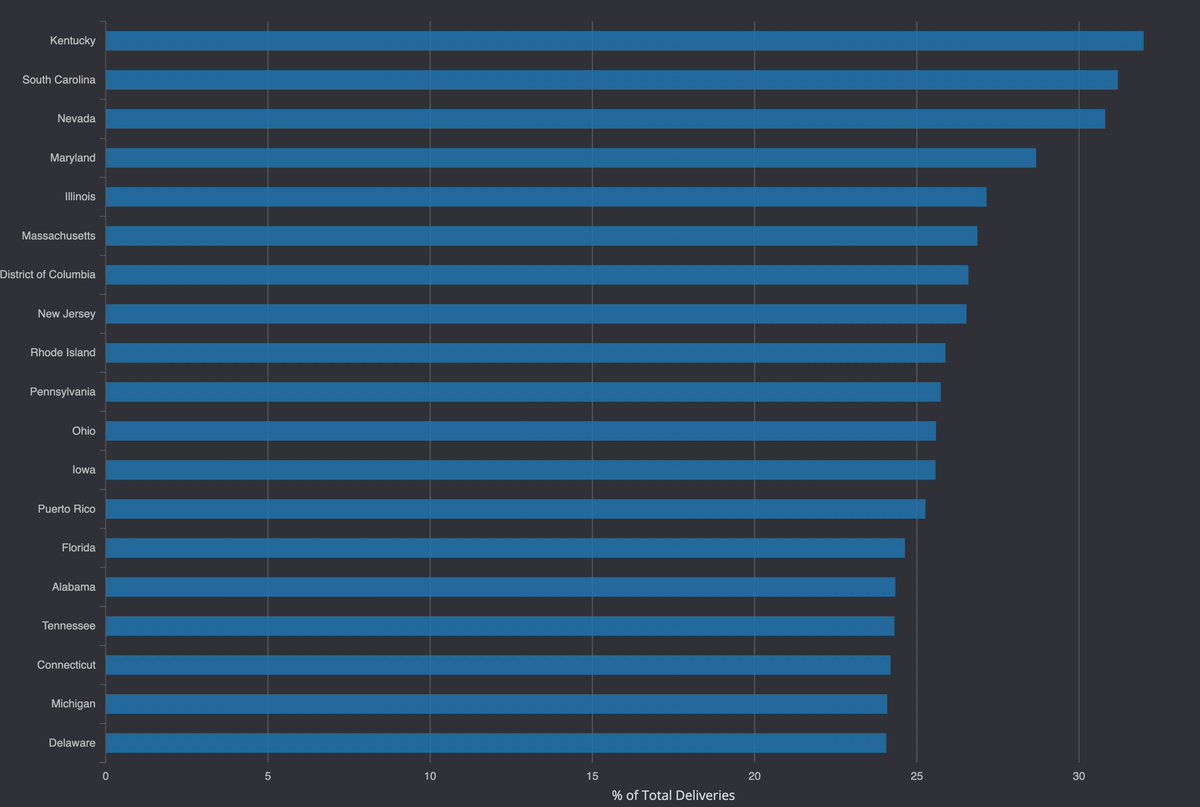 In the 19 states (below) the share of COVID-19 vaccine doses allocated to retail pharmacies is higher than the national average (> 24%)source: CDC" title="https://abs.twimg.com/emoji/v2/... draggable="false" alt="👀" title="Augen" aria-label="Emoji: Augen"> In the 19 states (below) the share of COVID-19 vaccine doses allocated to retail pharmacies is higher than the national average (> 24%)source: CDC" class="img-responsive" style="max-width:100%;"/>
In the 19 states (below) the share of COVID-19 vaccine doses allocated to retail pharmacies is higher than the national average (> 24%)source: CDC" title="https://abs.twimg.com/emoji/v2/... draggable="false" alt="👀" title="Augen" aria-label="Emoji: Augen"> In the 19 states (below) the share of COVID-19 vaccine doses allocated to retail pharmacies is higher than the national average (> 24%)source: CDC" class="img-responsive" style="max-width:100%;"/>
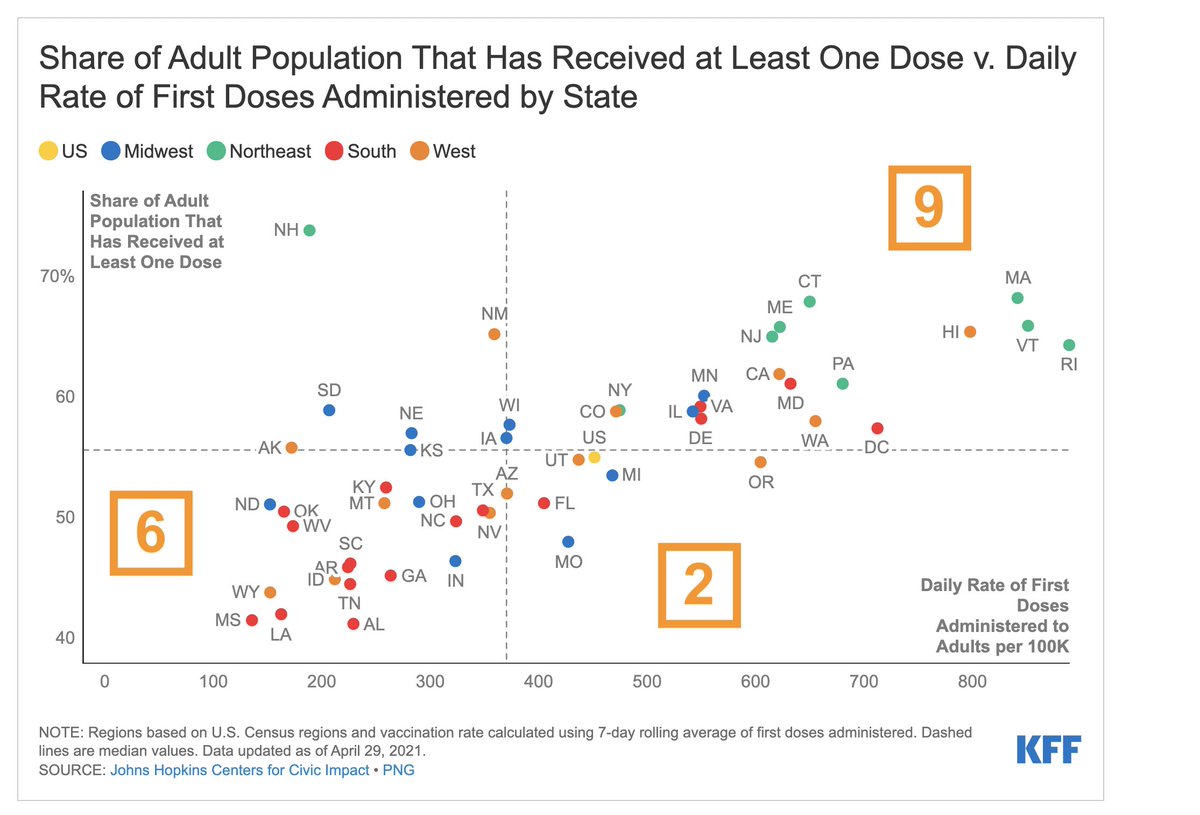 Kentucky, South Carolina, and Nevada are the 3 states with the highest share of doses allocated to retail pharmacies *and* they are lagging in their vaccination efforts overall according to a @KFF analysis.source: CDC" title="https://abs.twimg.com/emoji/v2/... draggable="false" alt="👀" title="Augen" aria-label="Emoji: Augen"> Kentucky, South Carolina, and Nevada are the 3 states with the highest share of doses allocated to retail pharmacies *and* they are lagging in their vaccination efforts overall according to a @KFF analysis.source: CDC" class="img-responsive" style="max-width:100%;"/>
Kentucky, South Carolina, and Nevada are the 3 states with the highest share of doses allocated to retail pharmacies *and* they are lagging in their vaccination efforts overall according to a @KFF analysis.source: CDC" title="https://abs.twimg.com/emoji/v2/... draggable="false" alt="👀" title="Augen" aria-label="Emoji: Augen"> Kentucky, South Carolina, and Nevada are the 3 states with the highest share of doses allocated to retail pharmacies *and* they are lagging in their vaccination efforts overall according to a @KFF analysis.source: CDC" class="img-responsive" style="max-width:100%;"/>
 Maryland, Illinois, and Massachusetts rank 4-6 in terms of states with the highest share of COVID-19 vaccine doses allocated to retail pharmacies *and* they are doing well and/or above-average in their vaccination efforts according to a @KFF analysis.source: CDC" title="https://abs.twimg.com/emoji/v2/... draggable="false" alt="👀" title="Augen" aria-label="Emoji: Augen"> Maryland, Illinois, and Massachusetts rank 4-6 in terms of states with the highest share of COVID-19 vaccine doses allocated to retail pharmacies *and* they are doing well and/or above-average in their vaccination efforts according to a @KFF analysis.source: CDC" class="img-responsive" style="max-width:100%;"/>
Maryland, Illinois, and Massachusetts rank 4-6 in terms of states with the highest share of COVID-19 vaccine doses allocated to retail pharmacies *and* they are doing well and/or above-average in their vaccination efforts according to a @KFF analysis.source: CDC" title="https://abs.twimg.com/emoji/v2/... draggable="false" alt="👀" title="Augen" aria-label="Emoji: Augen"> Maryland, Illinois, and Massachusetts rank 4-6 in terms of states with the highest share of COVID-19 vaccine doses allocated to retail pharmacies *and* they are doing well and/or above-average in their vaccination efforts according to a @KFF analysis.source: CDC" class="img-responsive" style="max-width:100%;"/>
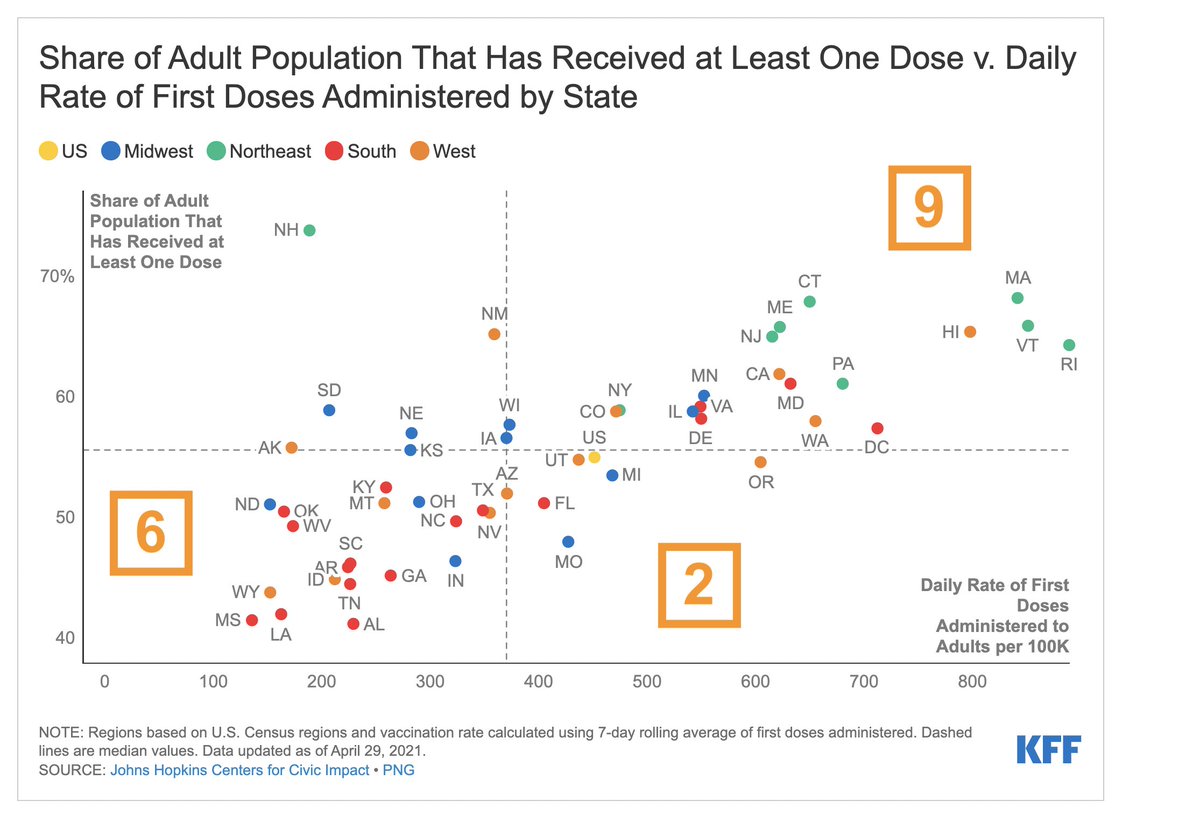 Taken together, the data suggests that the federal retail pharmacy program is:https://abs.twimg.com/emoji/v2/... draggable="false" alt="🔸" title="Kleine orangene Raute" aria-label="Emoji: Kleine orangene Raute">good strategy in the Northeasthttps://abs.twimg.com/emoji/v2/... draggable="false" alt="🔸" title="Kleine orangene Raute" aria-label="Emoji: Kleine orangene Raute">bad fit for the South + Nevadahttps://abs.twimg.com/emoji/v2/... draggable="false" alt="🔸" title="Kleine orangene Raute" aria-label="Emoji: Kleine orangene Raute">neither good or bad for the rest of the countrysource: CDC, KFFKFF analysis URL: https://www.kff.org/policy-wa..." title="https://abs.twimg.com/emoji/v2/... draggable="false" alt="🔥" title="Feuer" aria-label="Emoji: Feuer">Taken together, the data suggests that the federal retail pharmacy program is:https://abs.twimg.com/emoji/v2/... draggable="false" alt="🔸" title="Kleine orangene Raute" aria-label="Emoji: Kleine orangene Raute">good strategy in the Northeasthttps://abs.twimg.com/emoji/v2/... draggable="false" alt="🔸" title="Kleine orangene Raute" aria-label="Emoji: Kleine orangene Raute">bad fit for the South + Nevadahttps://abs.twimg.com/emoji/v2/... draggable="false" alt="🔸" title="Kleine orangene Raute" aria-label="Emoji: Kleine orangene Raute">neither good or bad for the rest of the countrysource: CDC, KFFKFF analysis URL: https://www.kff.org/policy-wa...">
Taken together, the data suggests that the federal retail pharmacy program is:https://abs.twimg.com/emoji/v2/... draggable="false" alt="🔸" title="Kleine orangene Raute" aria-label="Emoji: Kleine orangene Raute">good strategy in the Northeasthttps://abs.twimg.com/emoji/v2/... draggable="false" alt="🔸" title="Kleine orangene Raute" aria-label="Emoji: Kleine orangene Raute">bad fit for the South + Nevadahttps://abs.twimg.com/emoji/v2/... draggable="false" alt="🔸" title="Kleine orangene Raute" aria-label="Emoji: Kleine orangene Raute">neither good or bad for the rest of the countrysource: CDC, KFFKFF analysis URL: https://www.kff.org/policy-wa..." title="https://abs.twimg.com/emoji/v2/... draggable="false" alt="🔥" title="Feuer" aria-label="Emoji: Feuer">Taken together, the data suggests that the federal retail pharmacy program is:https://abs.twimg.com/emoji/v2/... draggable="false" alt="🔸" title="Kleine orangene Raute" aria-label="Emoji: Kleine orangene Raute">good strategy in the Northeasthttps://abs.twimg.com/emoji/v2/... draggable="false" alt="🔸" title="Kleine orangene Raute" aria-label="Emoji: Kleine orangene Raute">bad fit for the South + Nevadahttps://abs.twimg.com/emoji/v2/... draggable="false" alt="🔸" title="Kleine orangene Raute" aria-label="Emoji: Kleine orangene Raute">neither good or bad for the rest of the countrysource: CDC, KFFKFF analysis URL: https://www.kff.org/policy-wa...">
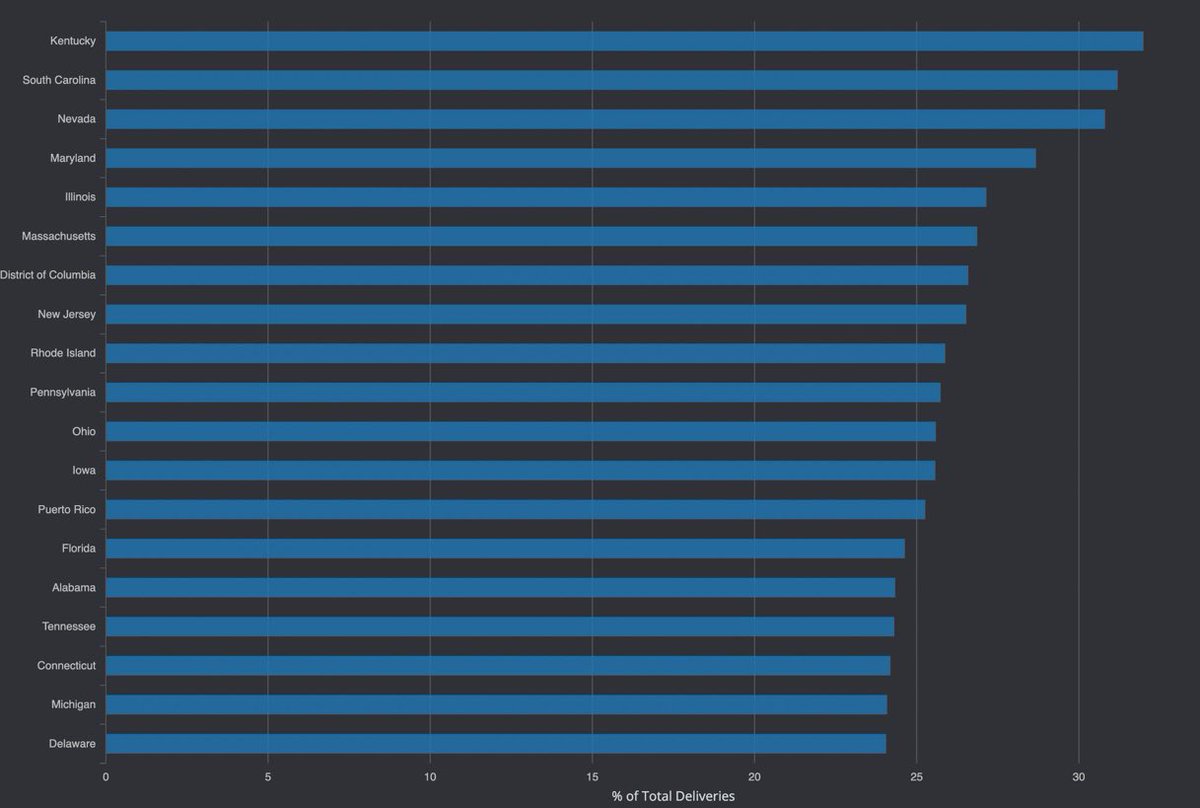 Taken together, the data suggests that the federal retail pharmacy program is:https://abs.twimg.com/emoji/v2/... draggable="false" alt="🔸" title="Kleine orangene Raute" aria-label="Emoji: Kleine orangene Raute">good strategy in the Northeasthttps://abs.twimg.com/emoji/v2/... draggable="false" alt="🔸" title="Kleine orangene Raute" aria-label="Emoji: Kleine orangene Raute">bad fit for the South + Nevadahttps://abs.twimg.com/emoji/v2/... draggable="false" alt="🔸" title="Kleine orangene Raute" aria-label="Emoji: Kleine orangene Raute">neither good or bad for the rest of the countrysource: CDC, KFFKFF analysis URL: https://www.kff.org/policy-wa..." title="https://abs.twimg.com/emoji/v2/... draggable="false" alt="🔥" title="Feuer" aria-label="Emoji: Feuer">Taken together, the data suggests that the federal retail pharmacy program is:https://abs.twimg.com/emoji/v2/... draggable="false" alt="🔸" title="Kleine orangene Raute" aria-label="Emoji: Kleine orangene Raute">good strategy in the Northeasthttps://abs.twimg.com/emoji/v2/... draggable="false" alt="🔸" title="Kleine orangene Raute" aria-label="Emoji: Kleine orangene Raute">bad fit for the South + Nevadahttps://abs.twimg.com/emoji/v2/... draggable="false" alt="🔸" title="Kleine orangene Raute" aria-label="Emoji: Kleine orangene Raute">neither good or bad for the rest of the countrysource: CDC, KFFKFF analysis URL: https://www.kff.org/policy-wa...">
Taken together, the data suggests that the federal retail pharmacy program is:https://abs.twimg.com/emoji/v2/... draggable="false" alt="🔸" title="Kleine orangene Raute" aria-label="Emoji: Kleine orangene Raute">good strategy in the Northeasthttps://abs.twimg.com/emoji/v2/... draggable="false" alt="🔸" title="Kleine orangene Raute" aria-label="Emoji: Kleine orangene Raute">bad fit for the South + Nevadahttps://abs.twimg.com/emoji/v2/... draggable="false" alt="🔸" title="Kleine orangene Raute" aria-label="Emoji: Kleine orangene Raute">neither good or bad for the rest of the countrysource: CDC, KFFKFF analysis URL: https://www.kff.org/policy-wa..." title="https://abs.twimg.com/emoji/v2/... draggable="false" alt="🔥" title="Feuer" aria-label="Emoji: Feuer">Taken together, the data suggests that the federal retail pharmacy program is:https://abs.twimg.com/emoji/v2/... draggable="false" alt="🔸" title="Kleine orangene Raute" aria-label="Emoji: Kleine orangene Raute">good strategy in the Northeasthttps://abs.twimg.com/emoji/v2/... draggable="false" alt="🔸" title="Kleine orangene Raute" aria-label="Emoji: Kleine orangene Raute">bad fit for the South + Nevadahttps://abs.twimg.com/emoji/v2/... draggable="false" alt="🔸" title="Kleine orangene Raute" aria-label="Emoji: Kleine orangene Raute">neither good or bad for the rest of the countrysource: CDC, KFFKFF analysis URL: https://www.kff.org/policy-wa...">
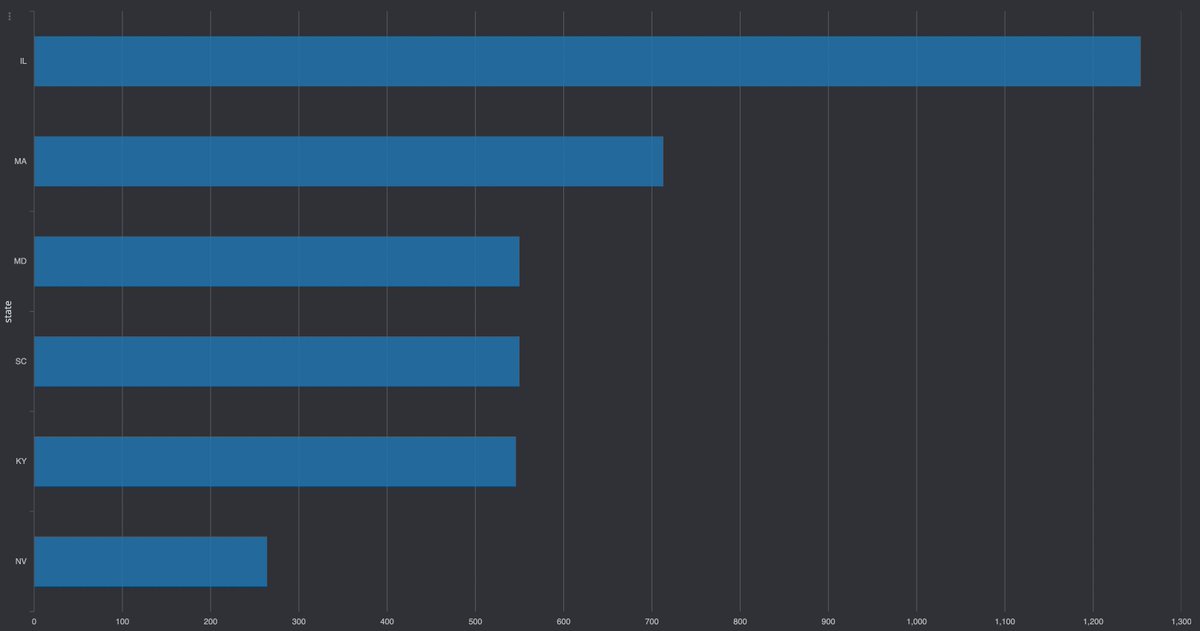 https://abs.twimg.com/emoji/v2/... draggable="false" alt="⤵️" title="Nach rechts zeigender Pfeil mit Krümmung nach unten" aria-label="Emoji: Nach rechts zeigender Pfeil mit Krümmung nach unten">https://abs.twimg.com/emoji/v2/... draggable="false" alt="🔸" title="Kleine orangene Raute" aria-label="Emoji: Kleine orangene Raute">Nevada: 11300 persons/pharmacyvs.https://abs.twimg.com/emoji/v2/... draggable="false" alt="🔸" title="Kleine orangene Raute" aria-label="Emoji: Kleine orangene Raute">Massachusetts: 9500 persons/pharmacy https://twitter.com/datadrive..." title="So, why is the federal retail pharmacy program good in some instances, but not in others? At least part of the difference has to do with the ratio of population-to-pharmacies https://abs.twimg.com/emoji/v2/... draggable="false" alt="👀" title="Augen" aria-label="Emoji: Augen">https://abs.twimg.com/emoji/v2/... draggable="false" alt="⤵️" title="Nach rechts zeigender Pfeil mit Krümmung nach unten" aria-label="Emoji: Nach rechts zeigender Pfeil mit Krümmung nach unten">https://abs.twimg.com/emoji/v2/... draggable="false" alt="🔸" title="Kleine orangene Raute" aria-label="Emoji: Kleine orangene Raute">Nevada: 11300 persons/pharmacyvs.https://abs.twimg.com/emoji/v2/... draggable="false" alt="🔸" title="Kleine orangene Raute" aria-label="Emoji: Kleine orangene Raute">Massachusetts: 9500 persons/pharmacy https://twitter.com/datadrive..." class="img-responsive" style="max-width:100%;"/>
https://abs.twimg.com/emoji/v2/... draggable="false" alt="⤵️" title="Nach rechts zeigender Pfeil mit Krümmung nach unten" aria-label="Emoji: Nach rechts zeigender Pfeil mit Krümmung nach unten">https://abs.twimg.com/emoji/v2/... draggable="false" alt="🔸" title="Kleine orangene Raute" aria-label="Emoji: Kleine orangene Raute">Nevada: 11300 persons/pharmacyvs.https://abs.twimg.com/emoji/v2/... draggable="false" alt="🔸" title="Kleine orangene Raute" aria-label="Emoji: Kleine orangene Raute">Massachusetts: 9500 persons/pharmacy https://twitter.com/datadrive..." title="So, why is the federal retail pharmacy program good in some instances, but not in others? At least part of the difference has to do with the ratio of population-to-pharmacies https://abs.twimg.com/emoji/v2/... draggable="false" alt="👀" title="Augen" aria-label="Emoji: Augen">https://abs.twimg.com/emoji/v2/... draggable="false" alt="⤵️" title="Nach rechts zeigender Pfeil mit Krümmung nach unten" aria-label="Emoji: Nach rechts zeigender Pfeil mit Krümmung nach unten">https://abs.twimg.com/emoji/v2/... draggable="false" alt="🔸" title="Kleine orangene Raute" aria-label="Emoji: Kleine orangene Raute">Nevada: 11300 persons/pharmacyvs.https://abs.twimg.com/emoji/v2/... draggable="false" alt="🔸" title="Kleine orangene Raute" aria-label="Emoji: Kleine orangene Raute">Massachusetts: 9500 persons/pharmacy https://twitter.com/datadrive..." class="img-responsive" style="max-width:100%;"/>
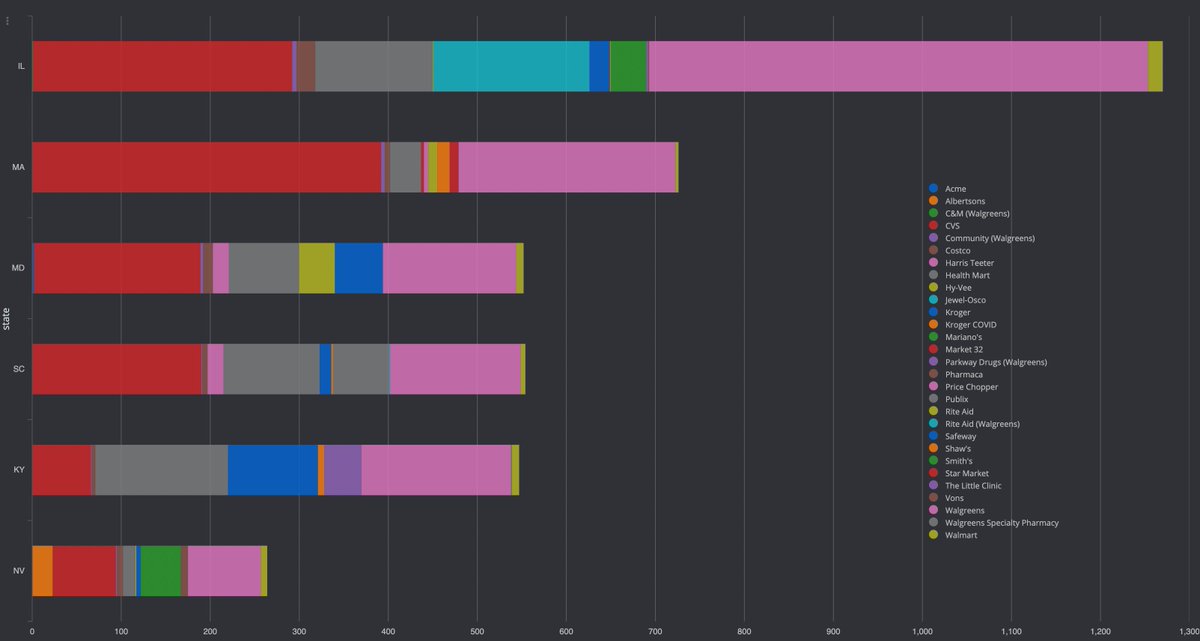 https://abs.twimg.com/emoji/v2/... draggable="false" alt="⤵️" title="Nach rechts zeigender Pfeil mit Krümmung nach unten" aria-label="Emoji: Nach rechts zeigender Pfeil mit Krümmung nach unten"> https://twitter.com/datadrive..." title="It may also have something to do with the pharmacies themselves. Nevada, for instance, there are proportionally more Albertsons and Smith’s pharmacies than in Maryland (both states have the roughly the same number of pharmacies per capita) https://abs.twimg.com/emoji/v2/... draggable="false" alt="👀" title="Augen" aria-label="Emoji: Augen">https://abs.twimg.com/emoji/v2/... draggable="false" alt="⤵️" title="Nach rechts zeigender Pfeil mit Krümmung nach unten" aria-label="Emoji: Nach rechts zeigender Pfeil mit Krümmung nach unten"> https://twitter.com/datadrive..." class="img-responsive" style="max-width:100%;"/>
https://abs.twimg.com/emoji/v2/... draggable="false" alt="⤵️" title="Nach rechts zeigender Pfeil mit Krümmung nach unten" aria-label="Emoji: Nach rechts zeigender Pfeil mit Krümmung nach unten"> https://twitter.com/datadrive..." title="It may also have something to do with the pharmacies themselves. Nevada, for instance, there are proportionally more Albertsons and Smith’s pharmacies than in Maryland (both states have the roughly the same number of pharmacies per capita) https://abs.twimg.com/emoji/v2/... draggable="false" alt="👀" title="Augen" aria-label="Emoji: Augen">https://abs.twimg.com/emoji/v2/... draggable="false" alt="⤵️" title="Nach rechts zeigender Pfeil mit Krümmung nach unten" aria-label="Emoji: Nach rechts zeigender Pfeil mit Krümmung nach unten"> https://twitter.com/datadrive..." class="img-responsive" style="max-width:100%;"/>
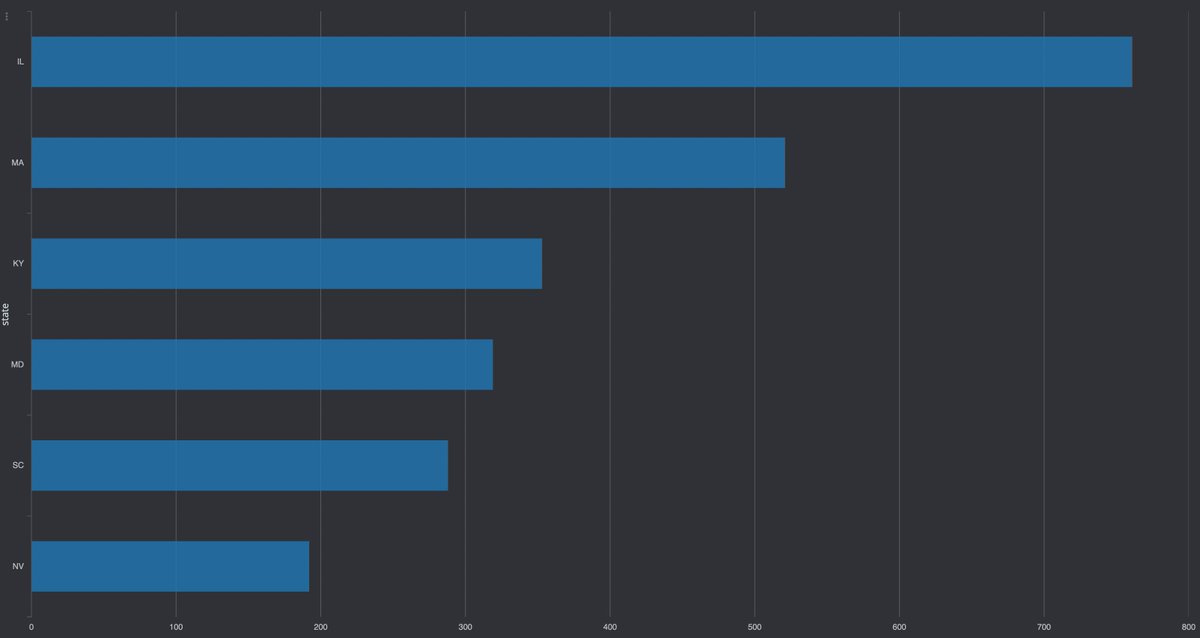 Excluding pharmacies without confirmed availability the number of *actual* vaccination sites drops by:https://abs.twimg.com/emoji/v2/... draggable="false" alt="🔸" title="Kleine orangene Raute" aria-label="Emoji: Kleine orangene Raute">27% in Nevadahttps://abs.twimg.com/emoji/v2/... draggable="false" alt="🔸" title="Kleine orangene Raute" aria-label="Emoji: Kleine orangene Raute">42% in Maryland loseshttps://abs.twimg.com/emoji/v2/... draggable="false" alt="🔸" title="Kleine orangene Raute" aria-label="Emoji: Kleine orangene Raute">47% in South CarolinaLet that sink in.If you’ve got a 30 min lunch break, are you going to roll the dice? cc @WHCOVIDResponse" title="https://abs.twimg.com/emoji/v2/... draggable="false" alt="🔥" title="Feuer" aria-label="Emoji: Feuer"> Excluding pharmacies without confirmed availability the number of *actual* vaccination sites drops by:https://abs.twimg.com/emoji/v2/... draggable="false" alt="🔸" title="Kleine orangene Raute" aria-label="Emoji: Kleine orangene Raute">27% in Nevadahttps://abs.twimg.com/emoji/v2/... draggable="false" alt="🔸" title="Kleine orangene Raute" aria-label="Emoji: Kleine orangene Raute">42% in Maryland loseshttps://abs.twimg.com/emoji/v2/... draggable="false" alt="🔸" title="Kleine orangene Raute" aria-label="Emoji: Kleine orangene Raute">47% in South CarolinaLet that sink in.If you’ve got a 30 min lunch break, are you going to roll the dice? cc @WHCOVIDResponse" class="img-responsive" style="max-width:100%;"/>
Excluding pharmacies without confirmed availability the number of *actual* vaccination sites drops by:https://abs.twimg.com/emoji/v2/... draggable="false" alt="🔸" title="Kleine orangene Raute" aria-label="Emoji: Kleine orangene Raute">27% in Nevadahttps://abs.twimg.com/emoji/v2/... draggable="false" alt="🔸" title="Kleine orangene Raute" aria-label="Emoji: Kleine orangene Raute">42% in Maryland loseshttps://abs.twimg.com/emoji/v2/... draggable="false" alt="🔸" title="Kleine orangene Raute" aria-label="Emoji: Kleine orangene Raute">47% in South CarolinaLet that sink in.If you’ve got a 30 min lunch break, are you going to roll the dice? cc @WHCOVIDResponse" title="https://abs.twimg.com/emoji/v2/... draggable="false" alt="🔥" title="Feuer" aria-label="Emoji: Feuer"> Excluding pharmacies without confirmed availability the number of *actual* vaccination sites drops by:https://abs.twimg.com/emoji/v2/... draggable="false" alt="🔸" title="Kleine orangene Raute" aria-label="Emoji: Kleine orangene Raute">27% in Nevadahttps://abs.twimg.com/emoji/v2/... draggable="false" alt="🔸" title="Kleine orangene Raute" aria-label="Emoji: Kleine orangene Raute">42% in Maryland loseshttps://abs.twimg.com/emoji/v2/... draggable="false" alt="🔸" title="Kleine orangene Raute" aria-label="Emoji: Kleine orangene Raute">47% in South CarolinaLet that sink in.If you’ve got a 30 min lunch break, are you going to roll the dice? cc @WHCOVIDResponse" class="img-responsive" style="max-width:100%;"/>


